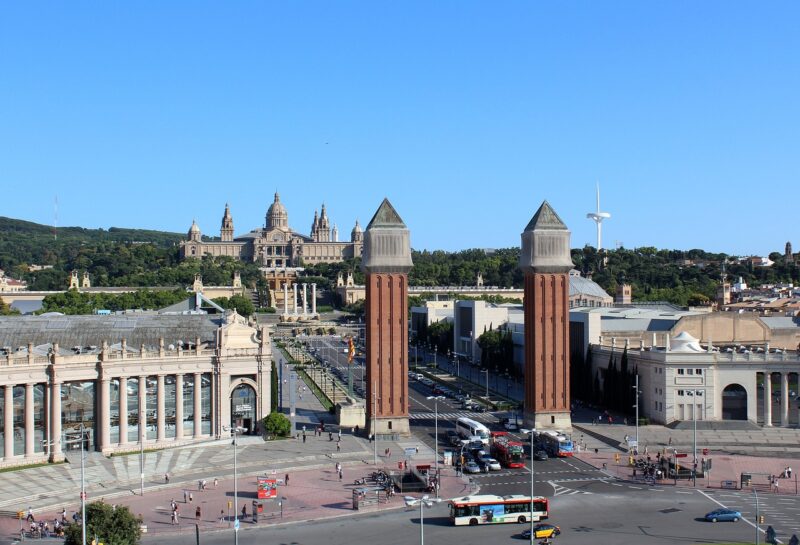Montjuïc Castle, perched atop Montjuïc Hill, is one of Barcelona’s most iconic landmarks. This formidable fortress has witnessed centuries of history, serving various roles from a military stronghold to a political prison. Today, it stands as a symbol of the city’s rich cultural heritage and a popular tourist destination.
Table of Contents
- The Location and Scenic Views
- Historical Background
- Architectural Features
- Role in Military History
- Political Significance
- Modern History and Restoration
- The Castle Today
- Cultural and Social Impact
- Educational Programs
- Exhibitions and Museums
- Gardens and Outdoor Spaces
- Events and Festivals
- Accessibility and Visitor Information
- Conclusion
- FAQs
The Location and Scenic Views
Located on Montjuïc Hill, the castle offers stunning panoramic views of Barcelona and the Mediterranean Sea. Its strategic position has always made it a crucial vantage point, and visitors today can enjoy breathtaking vistas that capture the essence of the city and its coastline.
Historical Background
Montjuïc Hill has been of strategic importance since ancient times. The castle itself was constructed in 1640 during the Catalan Revolt against King Philip IV of Spain. Originally built as a military fortress, it played a pivotal role in various conflicts and wars over the centuries.
Architectural Features
The castle boasts a robust and imposing structure, characterized by its star-shaped layout. The walls are thick and formidable, designed to withstand sieges and attacks. Notable features include the watchtowers, bastions, and the central courtyard, which has seen many historical events.
Role in Military History
Montjuïc Castle’s military significance is undeniable. It was a key defensive position during the War of the Spanish Succession and later, during the Napoleonic Wars. Perhaps most infamously, it served as a site of imprisonment and execution during the Spanish Civil War, leaving a dark mark on its history.
Political Significance
The castle has been a symbol of oppression and resistance. During the Franco regime, it was used to detain and execute political prisoners, including prominent figures like Lluís Companys, the President of Catalonia. These events have imbued the castle with profound political significance.
Modern History and Restoration
In the latter half of the 20th century, Montjuïc Castle transitioned from a military installation to a public monument. Restoration efforts have preserved its historical integrity while making it accessible to the public. These efforts are crucial in maintaining the castle as a historical and cultural site.
The Castle Today
Today, Montjuïc Castle is a popular tourist attraction managed by the city of Barcelona. It hosts a variety of exhibitions, cultural events, and educational programs. Visitors can explore its rich history while enjoying the beautiful surroundings.
Cultural and Social Impact
The castle plays a vital role in the cultural life of Barcelona. It hosts community events, concerts, and other activities that bring people together. Its presence on Montjuïc Hill adds to the area’s cultural significance and allure.
Educational Programs
Montjuïc Castle offers numerous educational programs, including guided tours that provide in-depth historical insights. Collaborations with schools and universities make it a valuable educational resource, helping to teach the history and significance of the site.
Exhibitions and Museums
The castle houses several exhibitions and museums, including a military museum that showcases artifacts and exhibits related to its martial past. These displays offer a glimpse into the castle’s history and its role in various historical events.
Gardens and Outdoor Spaces
Surrounding the castle are beautifully maintained gardens that provide a serene escape from the bustling city below. These gardens are perfect for leisurely strolls, picnics, and enjoying the natural beauty of Montjuïc Hill.
Events and Festivals
Montjuïc Castle is the venue for many annual events and festivals, including historical reenactments and cultural celebrations. These events draw locals and tourists alike, offering a vibrant and dynamic experience of the castle’s historical ambiance.
Accessibility and Visitor Information
Reaching Montjuïc Castle is easy, with various transportation options including buses, cable cars, and walking paths. The site is also equipped to accommodate visitors with disabilities, ensuring that everyone can enjoy its historical and cultural offerings.
Conclusion
Montjuïc Castle stands as a testament to Barcelona’s tumultuous and rich history. Its transformation from a military fortress to a cultural landmark reflects the resilience and enduring spirit of the city. A visit to Montjuïc Castle is not just a step back in time but a celebration of Barcelona’s heritage.
FAQs
What are the opening hours of Montjuïc Castle?
Montjuïc Castle is typically open daily from 10 AM to 8 PM, though hours may vary seasonally or for special events.
Is there an entrance fee to visit the castle?
Yes, there is an entrance fee, but it is relatively modest. Discounts are available for students, seniors, and groups.
Are guided tours available?
Yes, guided tours are available and highly recommended for those interested in a detailed understanding of the castle’s history.
What is the best time to visit Montjuïc Castle?
The best time to visit is during the spring and fall when the weather is pleasant, and the gardens are in full bloom.
Can Montjuïc Castle be rented for private events?
Yes, parts of the castle can be rented for private events, including weddings, corporate functions, and cultural events, offering a unique and historic setting.









